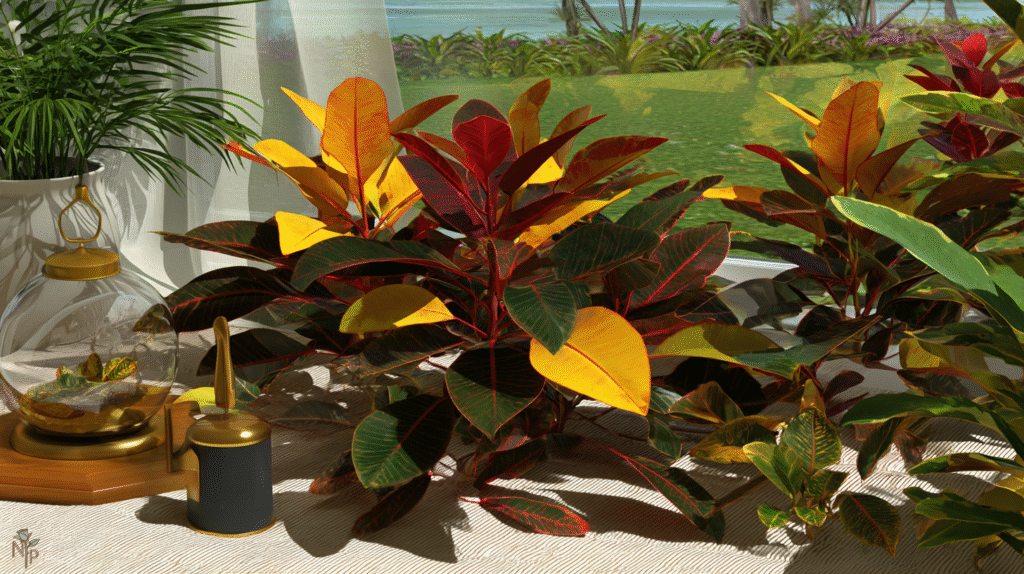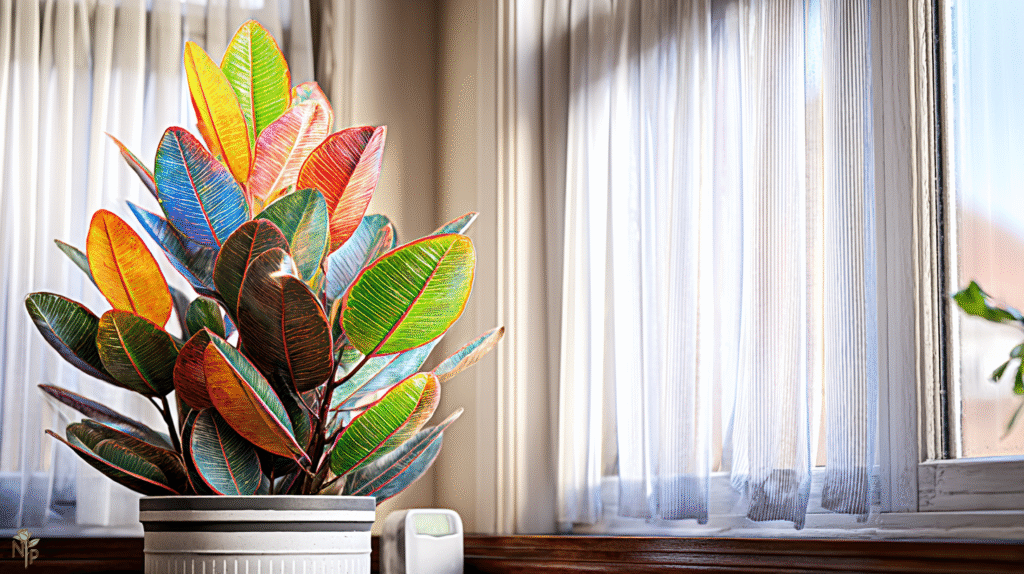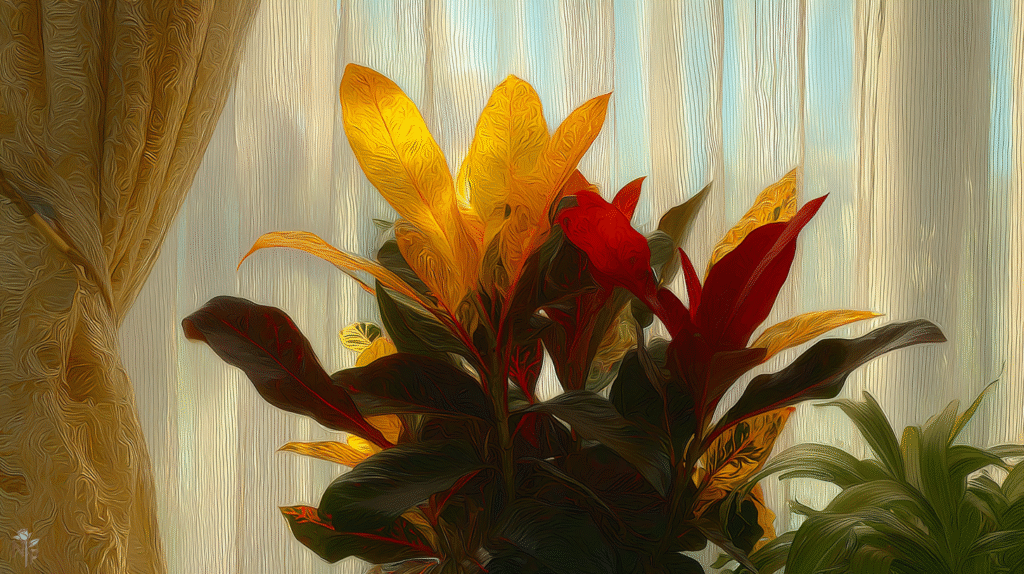The guy at Home Depot said crotons were “perfect for any bright room.” What he didn’t say was that crotons are the divas of the plant world who will literally drop every single leaf if you put them in the wrong spot. Ask me how I know.
My first croton lost all its leaves in two weeks. Every. Single. One. I’d wake up to a fresh pile of fallen leaves like it was autumn in my living room. Moved it to five different spots trying to make it happy. By the end, I had a $25 stick in a pot.
Three years and six crotons later (yeah, I’m stubborn), I finally have two that are not only keeping their leaves but actually growing new ones with colors so bright they look fake. Turns out the secret to crotons isn’t just finding a bright spot – it’s finding THEIR spot and then never, ever moving them again.
Why Crotons Are Such Location Snobs
Here’s what nobody explains: crotons aren’t actually houseplants. They’re tropical shrubs from Malaysia and Indonesia that we’re forcing to live in our climate-controlled boxes. In the wild, they get consistent everything – same temperature, same humidity, same light, every single day.
Your house? The temperature drops 10 degrees at night. The heater kicks on and drops humidity to desert levels. That “bright” corner gets zero light after 3 PM. No wonder they throw tantrums.
My breakthrough came when I stopped thinking “where looks good” and started thinking “where would a Malaysian shrub actually want to live.” Spoiler: not next to my drafty window.

The Light Situation Is More Complicated Than You Think
Every care guide: “Bright indirect light!” Super helpful. That’s like saying “drive at a safe speed.”
Here’s what bright indirect light actually means for crotons: imagine you’re wearing sunglasses on a sunny day. You can see everything clearly but the sun isn’t burning your retinas. That’s what your croton wants.
The spot that finally worked:
Three feet from my south-facing window, slightly to the side. Gets blasted with light from 11 AM to 4 PM but never direct sun. The leaves literally glow in this spot – reds look like fire, yellows like neon.
Spots that murdered my crotons:
- North window (too dim, leaves turned solid green then dropped)
- Right against south window (leaves bleached then crisped)
- Middle of the room with “ambient light” (slow death by darkness)
- Under a grow light meant for succulents (too intense, leaf burn city)
The weird part? My friend has hers thriving in an east window with only morning sun. Another friend has one under office fluorescents. It’s not about finding the “perfect” light – it’s about finding what works and then NEVER CHANGING IT.
The Temperature Drama Nobody Warns You About
Crotons want the temperature of a nice spring day. Forever. No variation. Good luck with that indoors.
My first croton was next to the front door. Every time someone came in during winter, cold air blast. Leaves dropped. Moved it away from the door to the window. Heat register below the window. Leaves dropped. Moved it to the kitchen. Temperature fluctuates every time I cook. Leaves dropped.
The goldilocks zone I finally found:
Interior wall of my living room, away from all windows, doors, and vents. Boring? Yes. But the temperature stays between 65-75°F year-round. The croton hasn’t dropped a leaf in eight months.
Pro tip I learned the hard way: crotons can feel drafts you can’t. Hold a lit candle where you want to put your plant. If the flame flickers, that spot’s too drafty. My “perfect” spot had an imperceptible draft from the AC vent across the room. Croton noticed immediately.
Humidity: The Make or Break Factor
My apartment in winter has 30% humidity on a good day. Crotons want 60% minimum. See the problem?
First attempt: misting. Useless and gave my plant fungus spots.
Second attempt: pebble tray. Raised humidity by maybe 5%. Croton didn’t care.
Third attempt: moved it to the bathroom with a frosted window. Not enough light, even with supplemental LED. Back to dropping leaves.
Final solution: humidifier. Not a cute little desktop one – a proper 4-liter tank that runs constantly in winter. Humidity stays at 55%. Croton finally stopped its dramatic leaf-dropping performance.
The placement hack that changed everything:
I grouped my croton with other humidity-loving plants (prayer plant, fern, another smaller croton). They create their own little microclimate. The humidity meter reads 10% higher in their corner than the rest of the room. Plus it looks intentional instead of like I just have random plants everywhere.
The Moving Mistake Everyone Makes
Found the perfect spot? Great. Now never move your croton again. EVER.
I’m not exaggerating. These plants hate change more than I hate small talk. Rotate it for “even growth”? Leaf drop. Move it to clean? Leaf drop. Shift it two inches to water the plant behind it? Believe it or not, leaf drop.
My current croton has been in the exact same spot for 14 months. Same orientation and everything. There’s literally a dust outline on the wall where it sits. I clean around it, water it in place, and pretend that corner doesn’t exist for rearranging purposes.
The vacation disaster:
Asked my neighbor to water my plants while I was gone. She moved my croton to the sink to water it, then put it back “exactly” where it was. Came home to 20 leaves on the floor. It was off by maybe 6 inches and turned 90 degrees. That’s all it took.

Seasonal Adjustments Without Moving
Summer hits and suddenly that perfect spot gets afternoon sun that’s too intense. But you can’t move the croton. So what do you do?
Sheer curtain. Seriously, that’s it. I hang a white sheer curtain just for July and August to filter the harsh afternoon sun. Croton stays put, light gets diffused, everyone’s happy.
Winter comes and that same spot is now too dark? I added a small grow light on a timer, positioned so it supplements but doesn’t replace the natural light. The croton never knows it’s getting help.
Signs You’ve Picked the Wrong Spot
Leaves dropping but staying green:
Too cold, too drafty, or you moved it. Check for air currents you might not feel.
Leaves turning solid green:
Not enough light. The gorgeous reds and yellows need serious brightness to develop.
Brown crispy edges:
Too much direct sun or heat source too close. Could also be low humidity but usually it’s heat.
Slow lean toward light:
Spot’s too dark. It’s literally trying to escape to find better light.
New growth but it’s pale:
Close but not quite enough light. Like it’s trying but struggling.
The Weird Spots That Actually Work
Behind my sheer curtained sliding door:
Sounds wrong but it gets bright filtered light all day, stays warm, and never gets direct sun. Croton’s thriving.
On top of my bookshelf near the ceiling:
Closer to the ceiling lights, warmer air rises, surprisingly perfect. Just annoying to water.
Kitchen counter away from the window:
Gets zero natural light but has two bright LED strips under the cabinets running 14 hours a day. Croton doesn’t know the difference.
My Current Setup That Actually Works
After all the dead crotons and leaf-dropping disasters, here’s where my two survivors live:
Living room croton:
- 3 feet from south window, to the side
- Interior wall, no drafts
- Humidifier 4 feet away
- Grouped with other plants
- Never moves, not even to water
- Sheer curtain in summer
Bedroom croton:
- East window ledge but set back 1 foot
- Radiator cover blocks heat from below
- Small humidifier on dresser nearby
- Has been there 18 months
- Still drops a leaf if I look at it wrong

The Real Talk
Crotons are beautiful but they’re not for everyone. If you like rearranging furniture, forget it. If you have pets that knock plants over, forget it. If you can’t commit to a humidifier, maybe forget it.
But if you can find that one perfect spot and leave them alone, they’re actually pretty low maintenance. I water mine maybe every 10 days, never move them, and they reward me with leaves that look like stained glass.
My friend bought one the same day as me three years ago. Hers is dead. Mine looks like it belongs in a tropical garden magazine. The only difference? She kept trying to find a “better” spot.






